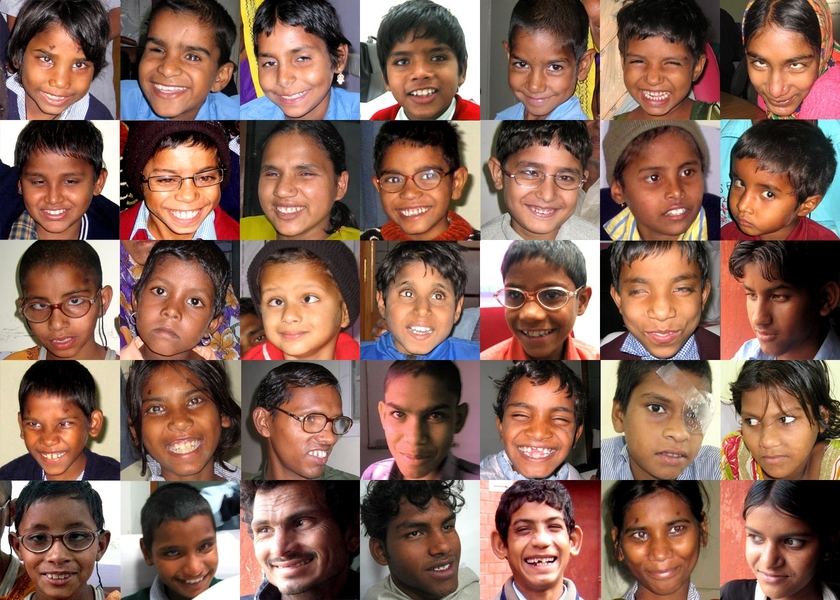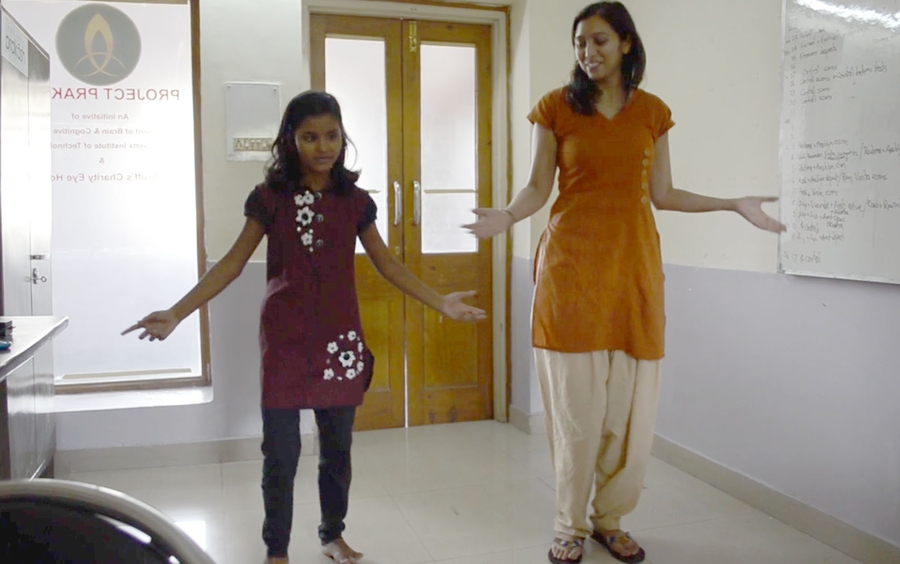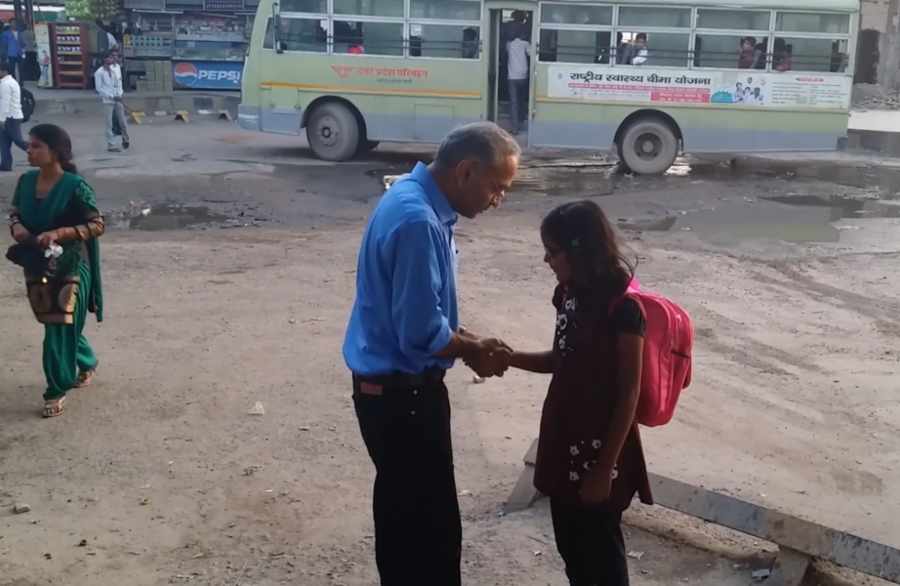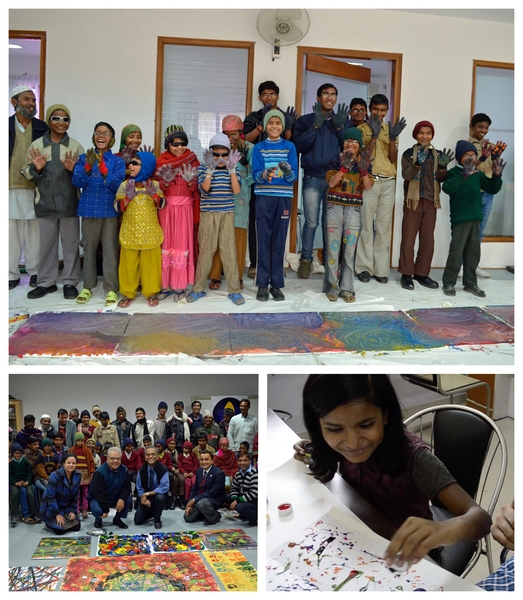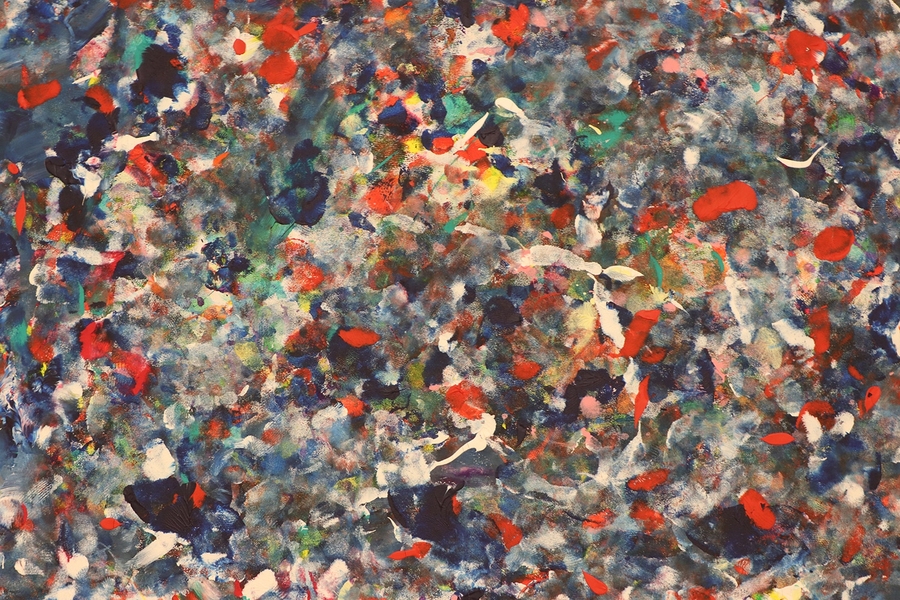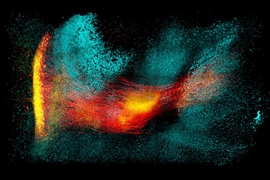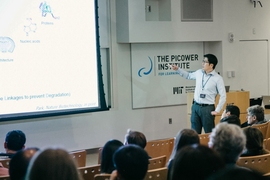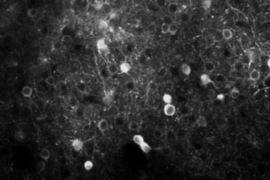Pawan Sinha, a professor of vision and computational neuroscience in the Department of Brain and Cognitive Sciences, first met Poonam when the girl was 13 years old. She lived in a remote village far from the urban bustle of Delhi, the second most-populous city in India. Poonam had grown up among lush trees and straw-thatched roofs and white cows with pointy horns grazing languidly along the dirt-packed road. But she had never seen any of it. Like many of the patients Sinha has worked with since he began Project Prakash, Poonam had been blind since birth due to dense cataracts, a treatable form of blindness more often seen in elderly patients.
Project Prakash, from the Sanskrit word for light, is a nonprofit organization that provides surgeries to congenitally blind children in India, and observes them during recovery to track the development of sight in the brain. Volunteers from Project Prakash travel to remote villages with limited access to health care to screen blind children and, if they are eligible, enroll them in the program.
Sinha first conceived of Project Prakash in 2002 while visiting his father in Delhi. He encountered two young siblings, living in poverty on the city streets, both blinded by treatable cataracts.
“This opened my eyes to the pervasiveness of childhood blindness in India, and more broadly in the developing world,” says Sinha. “Many children have treatable forms of blindness, but they stay blind because of lack of access to medical facilities, lack of knowledge of treatment options, and lack of financial resources to pursue medical care. These children languish in their blindness and lead difficult lives with little education, almost no prospects for employment and sadly, in many cases they die very young.”
Volunteers transported Poonam from her village to Dr. Shroff’s Charity Eye Hospital in Delhi, where, after a full examination, she received cataract removal surgery. The very next day, the bandages came off. During Poonam’s post-operative check-up, the caregiver held up her fingers both close to her face and from a distance and asked how many. Poonam answered correctly. She could see.
“The name Prakash reflects our immediate goal to bring light into the lives of children who suffer from blindness,” says Sinha. “In meeting this humanitarian need, as a neuroscientist I realized we had an scientific opportunity. With surgery, we can transition a child from blindness to sight in less than an hour and from the very moment the child’s bandages are removed, you have a ringside seat into the process of visual development.”
The call to action
According to data collected by Project Prakash, current estimates suggest that between 200,000 and 700,000 children suffer from potentially treatable forms of blindness, such as cataracts or corneal opacities. Only 50 percent of these children are expected to survive into adulthood, and many suffer physical or sexual abuse at some point in their lives.
Compelled to act, Sinha quickly realized he wanted to create a lasting impact beyond a one-time donation to cover the cost of cataract surgeries for individual children. From the perspective of a vision researcher, Sinha felt he was in a unique position to tackle this problem on a larger scale. He recognized an opportunity for synergy between this profound humanitarian need and a longstanding neuroscientific question he was interested in as a researcher. It would also address a common problem that arises when studying visual development.
“Until now, almost all the approaches we had to observe visual development happening in real-time was by working with infants, and they are notoriously difficult to work with experimentally,” says Sinha. “Not only are they unable to follow instructions or report out, their brains have many developmental processes progressing simultaneously, so it is hard to isolate one from the others. Visual development proceeds very rapidly, so we have a very short window to work with before infants become very sophisticated visual perceivers.”
And that is one of the key scientific benefits of Project Prakash. Older blind children, like Poonam and the kids Sinha met while visiting with his father, have physiologically mature brains, but have not yet been exposed to patterns in the visual world. This makes it much easier to identify the processes of visual development as they unfold as part of the follow-up care. Using functional MRI data acquired from post-operative Prakash patients imaged at various points throughout their recovery, Sinha and the rest of the Project Prakash team observe how a child’s brain incorporates new information into existing structural and functional organization. These studies then inform Sinha’s MIT lab work on computational models of visual learning.
Prakash patients range from children as young as 6 to young adults in their mid-20s; if a young person presents to the Project Prakash team with a treatable form of blindness, they won’t be turned away. A few days after surgery, children begin visual acuity tests using the standard eye charts anyone with glasses would be familiar with. While no child winds up with perfect vision, patients gain significant functional vision, and Project Prakash provides glasses to correct their sight further.
After securing an initial round of funding from the National Institutes of Health, Sinha officially launched Project Prakash with three of his students in 2004. Since then, Sinha has added 20 team members and together they have provided 500 surgeries and 43,000 ophthalmic screenings to children in need.
A ringside seat
Since Sinha established Project Prakash, the humanitarian work has become inextricably linked to the work in his research laboratory at MIT. Many of his lab members are also involved with Project Prakash and pursue a number of research questions related to data gathered from its patients. Typically, the research team travels to India twice a year to volunteer with the humanitarian efforts of the program, interact with the patients, and of course, to gather data.
Conventional wisdom in childhood blindness suggests that older children should not see significant gains post-surgery, since their brain’s visual machinery should be set. However, in one of his first key scientific findings enabled by Project Prakash, Sinha found that even young adults can make significant gains in visual function after surgical intervention.
Members of the Sinha laboratory at MIT have also found new avenues of research probing the development of different visual skills in the Prakash children. For example, Sruti Raja, a research associate in the Sinha laboratory, is working on a project that looks at sensitivity to visual motion before and after surgery. Another ongoing study, led by Sharon Gilad-Gutnick, a staff research scientist in Sinha’s lab and Project Prakash team member, looks at how patients learn to translate what they see into drawings.
“How are they able to recognize and then copy or draw from memory basic shapes?” says Gilad-Gutnick, who has worked with Sinha since she was an undergraduate. “What does that tell us about their internal representation of these shapes, and of objects in general? We are looking at that as a function of time after sight onset.”
Another study, published in the Proceedings of the National Academy of Sciences on Oct. 30, details how some Prakash patients struggle with the task of recognizing faces. Newborn babies have notoriously bad eyesight, with an average visual acuity of 20/600. According to the American Optometric Association, good visual acuity refers to the ability to see sharply and clearly. Normal visual acuity is referred to as 20/20 vision, which means that you can see patterns as clearly at 20 feet as an average person at the same distance. In this paper, the researchers hypothesize that poor eyesight has an important function in infant visual development, acting as a visual low-pass filter. The filter induces the brain to develop visual processing strategies that emphasize the gestalt rather than local details, or as Sinha describes it, the ‘forest from the trees.”
The Project Prakash patients miss out on this benefit of poor initial acuity, which leads to difficulty organizing and recognizing the spatial relationships of distinct faces. In the paper, Sinha and the team refer to this as the high-initial acuity (HIA) hypothesis. To test this hypothesis, Sinha’s research team used a deep learning algorithm designed to mimic the many layers of the human visual system. They fed the algorithm series of images simulating different visual learning scenarios, from only blurred images to only high resolution images to a mix of the two. The series that led to the most robust recognition performance began with blurred images and progressively increased in resolution — echoing the progression in normal human development and consistent with the HIA hypothesis.
These results have significant clinical implications. Post-operative outcomes for cases of congenital cataracts can potentially be improved by blurring visual stimuli to mimic the acuity of a newborn. By gradually increasing the resolution of visual stimuli, the regimen may provide the Prakash children’s brains the inducement to encode larger scale structures in images and improve subsequent recognition performance.
While the Project Prakash children are a unique subset of individuals, lessons learned from them can be applied to brain development in general. The work reported in the PNAS paper illustrates how studies of newly sighted children can inform our thinking of normal visual development, and also guide the creation of more powerful computational strategies for visual recognition.
“We are essentially providing a possible answer to why normal visual development unfolds in the way that it does,” Sinha says. “It's not just a limitation imposed upon us by immaturity of the retina, but it might actually have adaptive value.”
Looking beyond vision, this idea could potentially provide insight into auditory development as well; the muffling of sound by the amniotic sac may have adaptive significance akin to the blurring of images in early development.
Looking ahead
While Sinha appreciates the opportunity to tackle these scientific questions, he doesn’t lose sight of the transformative impact Project Prakash has on real lives. In the days following Poonam’s surgery, Project Prakash staff watched her blossom as she healed. She created artwork, she made up dance moves with her caregiving team, and she even took it upon herself to lead another blind patient receiving care at the hospital around the hallways. In addition to this newfound sense of independence and self-confidence, Poonam’s follow-up exams showed a marked improvement in visual abilities.
Poonam’s outcome was not an outlier for Project Prakash participants. Even though the speed of healing and level of visual acuity varies from patient to patient, most report significant improvement both to their vision and their quality of life. Sinha and his team surveyed a group of 60 patients and their families to gauge how their experience participating in Project Prakash improved their sense of independence, their ability to perform in school, and their relationships with friends, family and their communities.
“Across all of these dimensions, they reported big gains, and both patients and their families are uniformly ecstatic about the outcomes of the treatment, says Sinha. “When you take a step back to look at the whole picture, we have made a relatively small contribution by providing this routine surgery. But the consequence of that surgery is so profound for the child and for their family that the families think of us as more. It’s incredibly rewarding.”
But Prakash patients and their families are not the only ones who have been impacted by this work.
“In general, scientific research can be very frustrating, ambiguous and at times, difficult. But when you get to work so closely with children in need and you get to have that real-world impact in addition to pursuing these interesting questions, the motivation is huge,” says Gilad-Gutnik. “As scientists, I think we need to find more ways to work at this intersection of basic science and humanitarian need, and I think that neuroscience and the study of behavior presents a lot of unique opportunities to do that.”
Looking ahead, Project Prakash aims to improve patient outcomes even further through their newest initiative: a year-long residential educational program where patients who have fallen behind in school due to their visual impairment can receive specialized instruction, bringing them to an age-appropriate grade level before integrating them in local schools. They also intend to track how learning and education affects brain structure.
For Sinha, though his experience with Project Prakash has led to many immeasurably meaningful moments, meeting the Prakash patient named Poonam and following her success through the program hit especially close to home. His older sister was a doctor before her untimely death at age 25, and she was one of Sinha’s main sources of inspiration when he established Project Prakash. Her name was also Poonam.
“We are all shaped by the people we meet, and especially by the ones we admire,” says Sinha. “Seeing my sister’s devotion as a doctor to helping those in need, even at great cost to her own health, affected me greatly. Project Prakash is a small tribute to her memory, and the future of many more Poonams.”

